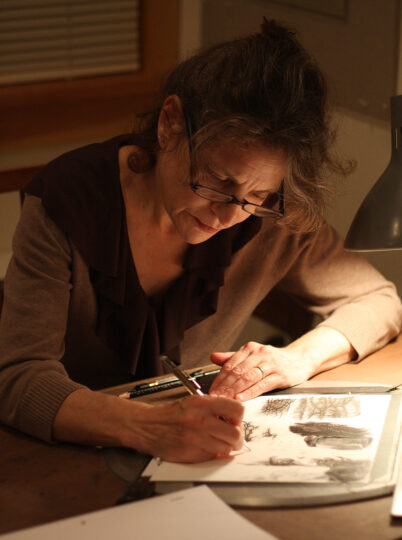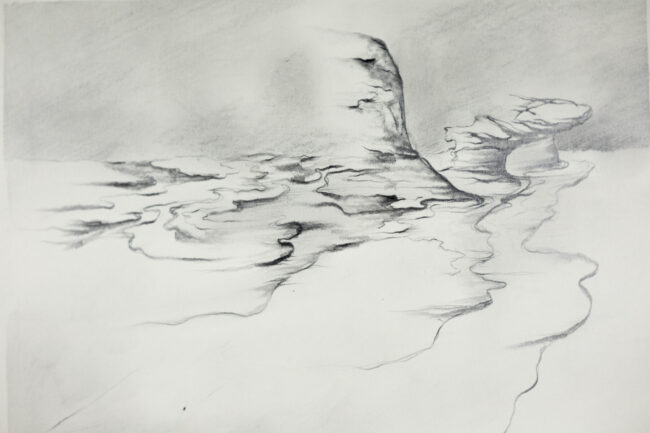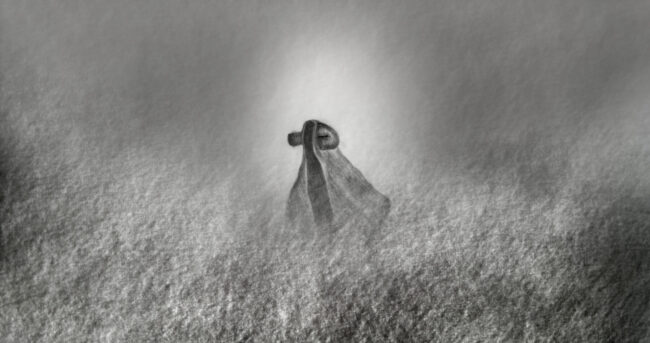This article about ASIFA-East member Amy Kravitz is reprinted with permission from the ASIFA International website.

“Many films are ‘about’ a topic, and have a message to deliver, or a story to tell. My films don’t embrace that approach. My intention is to create a non-verbal, visceral experience – an experience that transcends words. You have to understand the experience with your body, rather than with words.”
– Amy Kravitz
Amy Kravitz’s reputation as an inspiring, compassionate, and influential teacher has perhaps led some to forget that she’s also a hell of an animation artist. Her oeuvre-to-date is a small but mighty tribute to the power of paper, composed of films which show what a skilled hand can do with simple black and white dry media and a fibrous surface.
Through her films, Kravitz defines what she calls “the pure language” of abstract animation and, both as a filmmaker and a beloved instructor at Rhode Island School of Art and Design (RISD), raises the bar for experimental filmmakers everywhere. Working in black and white and a few shades in between, Kravitz’s process is centred around working with or against the paper’s surface, casting the viscosity and density of inks and crayon as the main performer.
Her three early works, The River Lethe (1985), The Trap (1988), and Roost (1998) are each an experiential impression in concept and a love letter to the richness of texture in substance, fusing a bright, full-value grayscale image with an enriching and informative soundtrack. Her newest film, The Hour Coat (2022), is a triumphant return to filmmaking after a busy absence spent focusing on family and teaching, easily echoing the tone of her earlier work without missing a beat.

The titular – and mythical – river in Lethe cleanses spirits of memories, allowing them to be reborn with a clean slate. Working via stream-of-consciousness, a method Kravitz says feels more authentic to her process, she addresses concepts around memory and loss by working the paper surface through addition and subtraction, creating a swirling balance of negative and positive space. The first of two collaborations with Caleb Sampson, Lethe’s soundtrack lays the perfect foundation to allow the film to sweep away our own reality, carrying off any worry if only for a few minutes.
The Trap, a film which aims to capture the imagined experience of a persecuted Jew travelling on a crowded train without food, water, belongings, and family to a death camp during World War II, leverages the potential bleakness of black contrasted with white to paint a devastating and terrifying picture. Struck while researching personal accounts of the holocaust by a particular question from author and holocaust survivor, Elie Weisel, who wondered why allied forces didn’t just bomb the train tracks knowing full well who was in them and where they were going.

Visually, a zippy series of starkly contrasted, quickly-moving shapes create the sense of whizzing by cold, harsh, unfamiliar landmarks and landscapes. The black and white palette drives home the feeling of utter helplessness from a situation devoid of warmth and hope. Kravitz’s signature media choices perfectly communicate her conceptualization of the awful experience it must have been to lose everything in such a way, feeling that it could easily have been stopped. Caleb Sampson’s soundtrack supports the scene of institutional and systematic imprisonment. Chilling tones and metallic sounds complete the picture perfectly, fully realizing the suggested message of the film.
By contrast, The Roost, while existing in the same black and white monochromatic universe, uses a gauzier texture to tell a more hopeful tale. Inspired by two things – the piercing cry of a rooster crow she worked with while editing sound on a job and Issac Bashevis Singer’s story called “Cockadoodledoo” – Amy describes the context around making Roost:
“So the film began with these inspirations, but as I was making it, I had children. So the film shifted focus from the Rooster to a nest with an egg. It is, in its own way, the affirmation of faith that one experiences from children even in the midst of other pain.”

Working with ink and non-absorbent paper to create a flurry of visual language, and incorporating a few graphic line drawings which hint at recognizable forms, Kravitz suggests a softer message, one of new life and new beginnings. The soundtrack, this time by Kravitz herself, is a rich cacophony of organic sounds and samples of music by experimental vocalist, Joan LaBarbara.
The Hour Coat, Kravitz’s latest film, is her longest to date and explores more fully the use of graphic line drawing and recognizable forms. A waistcoat twists and turns as it hovers ungrounded in space over an airy, wispy, grey, backdrop. Described simply as “between one life and the next”, The Hour Coat continues an exploration of softness that can be achieved by delving into greyscale strokes. The result is an ephemeral meditation on what lies beyond after we remove the cloak of life as we know it, showing Kravitz’s ever-deepening range within the black and white spectrum.
On the gap between The Roost and The Hour Coat, Kravitz says:
“I work slowly. Usually, whenever I try to do something quickly it just takes me LONGER. Over the past many years, I have had many responsibilities that have required extended attention. A colleague at RISD once told me, as we were discussing being teachers, mothers, and artists, that you can do two full-time jobs but you can’t do three full-time jobs. I had to earn a living (and I have a wonderful job that enables me to do that) and I would not compromise my family. Something had to give. My children are grown now, so I am able to spend more time again in my studio.”

Kravitz has had a long and balanced career thus far and continues to build her illustrious path forward as a beloved educator and artist. Her body of work is quantifiable evidence of Kravitz’s deliberate nurturing of her unique filmmaking voice, but the rich ground on which she stood throughout the process also comes through in each frame. Her films are a cohesive and impressive kicking-off point, and it will remain exciting to see what comes next.

